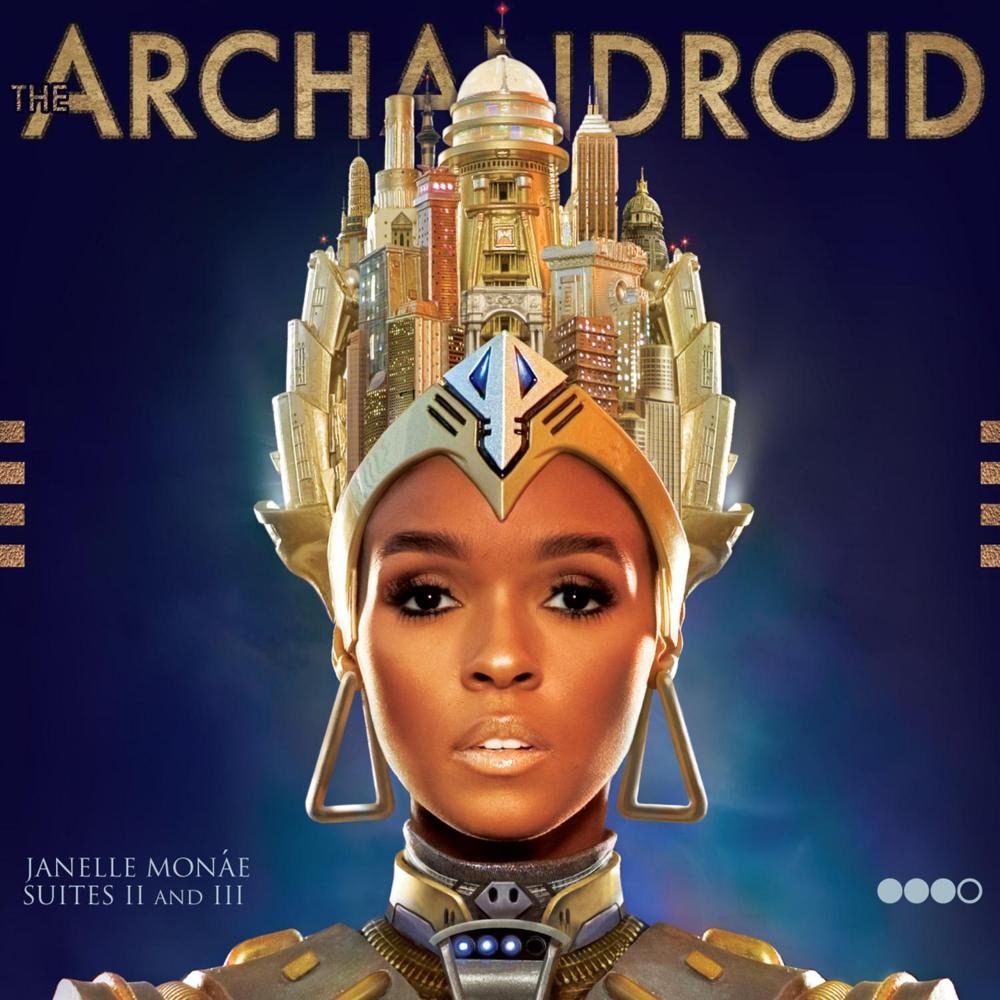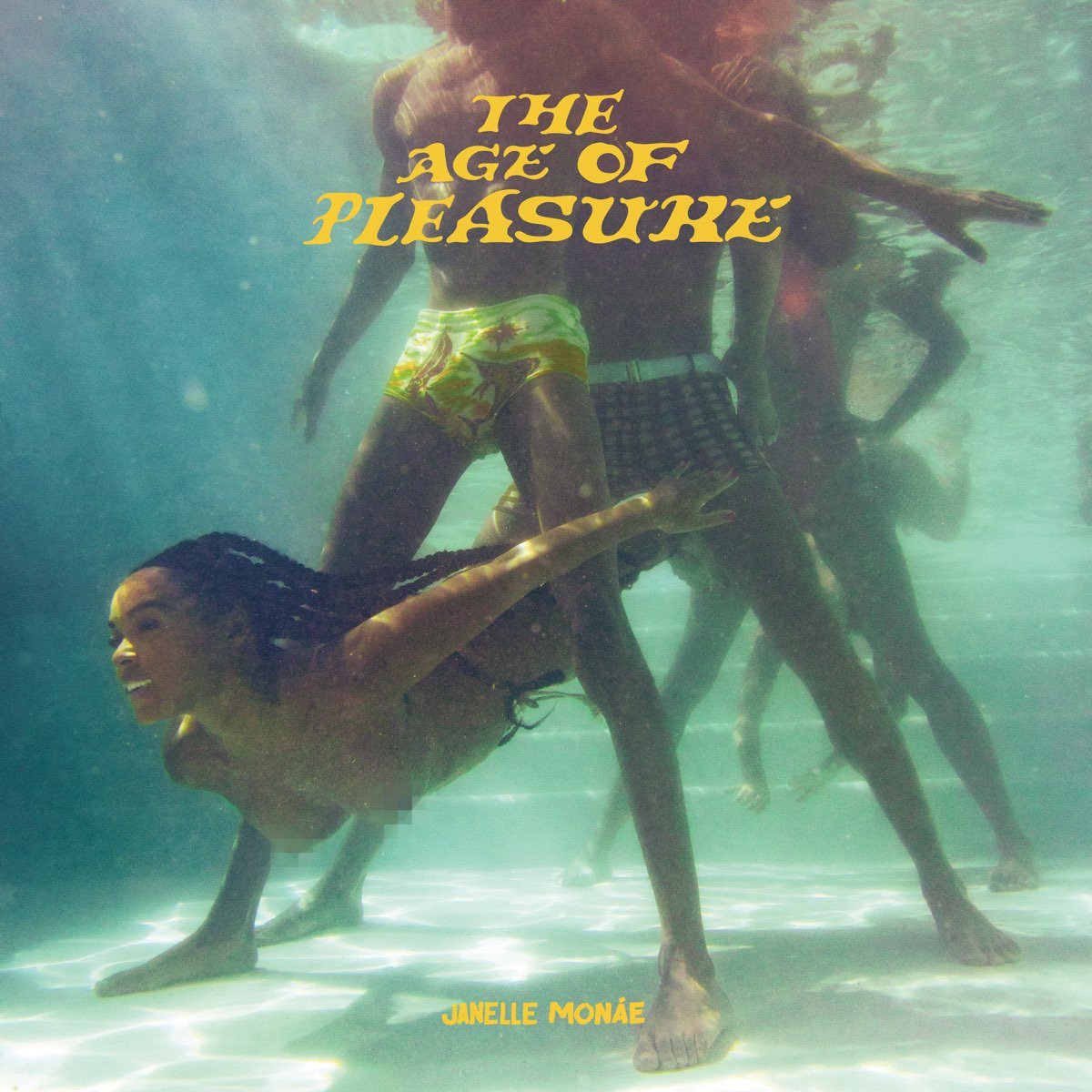Happy 10th Anniversary to Janelle Monáe’s second studio album The Electric Lady, originally released September 6, 2013.
Janelle Monáe almost ruined us all with her debut.
The ArchAndroid (2010) was a transcendent fury of art pop, neo-classical musical theater, and science fiction fantasy. It was such a compelling concept, it was always going to be a challenge to top.
That along with her preceding EP Metropolis (2007) compose three suites of a four-part series. Throughout, she never broke character as Cindi Mayweather, an android being hunted for the crime of falling in love with a human, her inamorato Sir Anthony Greendown. The third suite left dramatic cliffhangers. Will Cindi escape capture? Will she reunite with Anthony? What will happen next and will there be a film adaptation?
Accordingly, Monáe engineered and presented her transitional follow-up The Electric Lady, a euphonic clash of reality and fiction erupting from within. As previous, Monáe crafts the bulk of her project with the usual suspects—Roman GianArthur, Nate Wonder and Chuck Lightning of her Wondaland Arts Society. When cross-sectioned, it reveals a number of evolutions.
First, the formerly more adventurous blend of genres now focuses on playful R&B/soul, allowing the artist and esteemed guests space to frolic and funk together. Next, despite droid lore lingering in the interludes and such, Cindi’s storyline recedes. In its place, Monáe introduces more of her true self that doesn’t fit neatly into a scripted role. Rather than spin harrowing tales of robots fighting for their freedom, Monáe begins fighting for her own.
Atop the list to call for backup is Erykah Badu. The enigmatic R&B priestess once implored fans to “keep in mind I’m a artist, and I’m sensitive about my shit.” Similarly, Monáe’s off-the-wall first single “Q.U.E.E.N.” begs pardon as she drops her guard (“Am I a freak for dancing round? / Am I a freak for getting down? / I’m cutting up / Don’t cut me down”). Like a big sister sticking close in case her kin gets in a scuffle, Badu herself endorses the tune with a free swinging fourth verse. What the song represents becomes more important as layers peel away.
Lovers of the rip-roaring “Tightrope” or “Many Moons” could easily appreciate the unhinged punk abandon of “Dance Apocalyptic.” Borrowing Juicy J’s “Bandz a Make Her Dance” catchphrase for this second single, its promo clip finds Monáe blowing a gasket as the world comes to a manic end. Its “Smash-smash! Bang-bang!” energy had her clogging on David Letterman’s desk until her trademark pompadour came unpinned, an exertion usually reserved for tours only.
The tempo drops to a simmer when Miguel joins third single “Primetime.” An official description framed their meeting as “the early adventures of Cindi Mayweather and her first love Joey Vice.” But in truth, it needs no raison d'être other than two pretty singers singing prettily. The results are perfect for slow dancing, vertical or otherwise. Tempo picks back up on the go-go groove of final radio release “Electric Lady” featuring Solange on its cheeky refrain (“Ooh, shock it! Break it, baby!”).
Apart from its placement in Monáe’s spokesperson spot for CoverGirl, the criminally overlooked “We Were Rock & Roll” was a missed opportunity for a hit. This defiant, percussive praise for bygone romance gallops and whips wind as if to outrun heartache at its heels. As usual, Kellindo Parker’s guitar work makes the tune an inferno.
Watch the Official Videos:
The accreted mass of Monáe’s talent and celebrity attracted a brand-new class of guests to her orbit for Electric Lady, but none was more momentous than Prince. He would invite collaborators into his purple world, but rarely deigned to enter another’s, particularly not without a writing credit, and most certainly not on a recording owned by a major label. He refused artists sampling his work for years on the principle that artists should own their art.
All these precedents make his exception to appear on “Givin’ Em What They Love” landmark. Monáe and the patron saint of Minneapolis had a special friendship, and she gave him pole position on the CD. From the opening line (“I am sharper than a razor / Eyes made of lasers / Bolder than the truth”) through to her primal screams that burn into the blues-rock vamp, she made their shared moment an unforgettable one.
Like Monáe, Esperanza Spalding is another artist Prince enthusiastically championed. The two unite for the hypnotic jazz-soul of “Dorothy Dandridge Eyes.” Fresh from winning her first GRAMMYs earlier in 2013, Spalding fluoresces as a co-lead on the entrancing nocturne.
However understated, The Electric Lady was Monáe’s first time peeking out from behind her protective Cindi Mayweather shield. Once free, she rejoices in the ‘70s soul of The Jones Girls (“It’s Code”) and Miseducation-era Lauryn Hill’s regal pomp (“Victory”). Her tribute to women who have electrified her continues, spotlighting her mother (“Ghetto Woman”), the aforementioned Blacktress of legendary beauty (“Dorothy Dandridge Eyes”), and an escapist lamentation named after late astronaut and physicist Sally Ride, the first woman in outer space.
Only after Ride’s 2012 death was her identity as a queer woman revealed. In hindsight, Monáe had begun telegraphing her own queer identity long before its formal revelation. Packaging for The Electric Lady was emblazoned with the brush-rendered outline of a full-figured woman’s backside, an image Monáe had been meditating on in performances as early as 2011.
At the time, it seemed merely a bold declaration of femininity. These hints now glow like shoelaces under blacklight. Her furtive epilogue in “Givin’ Em What They Love” about a female groupie may have been merely literal (“Yeah, she was lookin’ at me for some undercover love”). On the “Our Favorite Fugitive” interlude, an incendiary radio caller shouts “Robot love is queer!” and the DJ responds, “How would you know it’s queer if you haven’t tried it?” The lyrics of “Q.U.E.E.N.” push against such homophobia (“Am I a freak because I like watching Mary? Is it a sin to like the way she wear her tights?”). And her bonus remake of the Jackson 5’s “I Want You Back” was precious and polite, such that no one noticed the subversion of not swapping genders to imply she was heterosexual.
This project was the last with Monáe committing to wear only black-and-white, and sometimes red. There was less Cindi Mayweather and more Monáe on display in the music video—or emotion picture—for “Electric Lady.” Elevating the culture of Atlanta, HBCUs, and the celebratory stepping of Greek organizations, Monáe gets way down in an afro blowout and bare midriff. She was ready to let even more colors show, declaring herself proudly pansexual shortly prior to the release of Dirty Computer (2018), and announcing themselves as non-binary, preferring she/they pronouns in 2022. The android is indeed human after all.
Enjoying this article? Click/tap on the album covers to explore more about Janelle Monáe:
Though The ArchAndroid was fresh, heady, captivating, and satisfying, it was only incidentally commercial. Its standout “Tightrope” kept Monáe’s electrifying stage presence in-demand on late night, daytime, and any TV show in-between. Even without a breakthrough like this on The Electric Lady, it still became her highest charting album in the US reaching #5 on the Billboard 200 and #3 on the Top R&B/Hip-Hop Albums.
The reggae lilt of The Electric Lady‘s closer “What an Experience” portended Monáe’s latest evolution immersing deeply into Caribbean sounds on The Age of Pleasure (2023). The Electric Lady expanded Cindi Mayweather’s Metropolis plot to a seven-part series (of which it supplied suites four and five). To date, the story has yet to conclude. However, Monáe is living out the mantra of “Q.U.E.E.N.” as if a promise: “Even if it makes others uncomfortable, I will love who I am.”
Presently, Monáe is busy living their best patriarchy-disrupting, breast-baring, feature film-leading, nationwide-touring life. She might very well be the conclusion we seek.
Listen:



